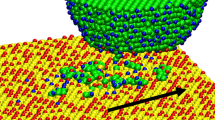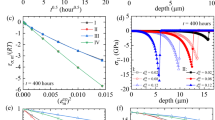Abstract
Atomistic simulations are carried out to analyze the influence of oxygen environment on nickel and copper surface roughness and notch initiation. The early stages of oxidation of nickel and copper surfaces are first simulated and compared with experimental observations. Various oxygen superstructures observed on metal surfaces are reproduced as well as the nucleation of small NiO embryos. Nickel and copper surface oxidation mechanisms are different and different “oxide” nano layers are formed. None of these superficial nano layers has a major influence on the mechanical behavior of surface slips as they do not change the surface roughness fatigue evolution and micro-notch production. These atomistic results agree with experimental studies which report similar development of persistent slip band surface relief in inert and in air environment. A general model for the estimation of surface slip irreversibility is also provided and the models of environment-assisted surface relief evolution and microcrack initiation are revisited.









Similar content being viewed by others
References
P.J. Woods: Low-amplitude fatigue of copper and copper–5 at.% aluminium single crystals. Philos. Mag. 28, 155 (1973).
K. Differt, U. Esmann, and H. Mughrabi: A model of extrusions and intrusions in fatigued metals II. Surface roughening by random irreversible slip. Philos. Mag. A 54, 237 (1986).
J. Lépinoux and L.P. Kubin: Dislocation mechanisms and steady states in the cyclic deformation of face centred cubic crystals. Philos. Mag. A 54, 631 (1986).
A. Weidner, M. Sauzay, and W. Skrotzki: Experimental evaluation of the cyclic slip irreversibility factor. Key Eng. Mater. 465, 223 (2011).
Z. Fan, O. Hardouin Duparc, and M. Sauzay: Molecular dynamics simulation of surface step reconstruction and irreversibility under cyclic loading. Acta Mater. 102, 149 (2016).
S. Suresh: Fatigue of Metals, 2nd ed. (Cambridge University Press, Cambridge, U.K., 2001).
N. Thompson, N. Wadsworth, and N. Louat: The origin of fatigue fracture in copper. Philos. Mag. 1, 113 (1956).
I.B. Kwon, M.E. Fine, and J. Weertman: Fatigue damage in copper single crystals at room and cryogenic temperatures. Acta Metall. 37, 2937 (1989).
I.B. Kwon, M.E. Fine, and J. Weertman: Microstructural studies on the initiation and growth of small fatigue crack at 298, 77, and 4.2 K in polycrystalline copper. Acta Metall. 37, 2927 (1989).
G. Venkataraman, T.S. Sriram, M.E. Fine, and Y.W. Chung: STM and surface analytical study of the effect of environment on fatigue crack initiation in silver single crystals I: Surface chemical effects. Scr. Metall. Mater. 24, 273 (1990).
T.S. Sriram, M.E. Fine, and Y.W. Chung: STM and surface analytical study of the effect of environment on fatigue crack initiation in silver single crystals II: Effects of oxygen partial pressure. Scr. Metall. Mater. 24, 279 (1990).
T.S. Sriram, M.E. Fine, and Y.W. Chung: The application of surface science to fatigue: The role of surface chemistry and surface modification in fatigue crack initiation in silver single crystals. Acta Metall. 40, 2769 (1992).
F.E. Fujita: Oxidation and dislocation mechanisms in fatigue-crack formation. Fracture of solids, D.C. Drucker and J.J. Gilman, eds. (Interscience Publishers, New York, New York, 1963), pp. 657–670.
C.E. Bauer, R. Speiser, and J-P. Hirth: Surface energy as a function of oxygen activity. Metall. Mater. Trans. 7, 75 (1976).
K. Tanaka and T. Mura: A dislocation model for fatigue crack initiation. J. Appl. Mech. 48, 97 (1981).
M. Sauzay and J. Liu: Simulation of surface crack initiation induced by slip localization and point defect kinetics. Adv. Mater. Res. 891–892, 542 (2014).
H. Shen, S.E. Podlaseck, and I.R. Kramer: Effect of vacuum on the fatigue life of aluminum. Acta Metall. 14, 341 (1966).
C. Laird and G.C. Smith: Initial stages of damage in high stress fatigue in some pure metals. Philos. Mag. 8, 1945–1963 (1963).
D.E. Martin: Plastic strain fatigue in air and vacuum. J. Basic Eng. 87, 850 (1965).
I.G. Greenfield: The effect of diffused surface layers and oxygen atmosphere on the development of fatigue striations and cracks in copper single crystals. Acta Metall. 19, 857 (1971).
J.M. Finney and C. Laird: Strain localization in cyclic deformation of copper single crystals. Philos. Mag. 31, 339 (1975).
R. Wang, H. Mughrabi, S. McGovern, and M. Rapp: Fatigue of copper single crystals in vacuum and in air I: Persistent slip bands and dislocation microstructures. Mater. Sci. Eng. 65, 219 (1984).
Z.S. Basinski and S.J. Basinski: Copper single crystal PSB morphology between 4.2 and 350 K. Acta Metall. 37, 3263 (1989).
D.E. Witmer, G.C. Farrington, and C. Laird: Changes in strain localization behavior induced by fatigue in inert environments. Acta Metall. 35, 1895 (1987).
N.M. Grinberg: The effect of vacuum on fatigue crack growth. Int. J. Fatigue 4, 83 (1982).
S. Plimpton: Fast parallel algorithms for short-range molecular dynamics. J. Comput. Phys. 117, 1 (1995).
S. Plimpton, A. Thompson, R. Shan, S. Moore, and A. Kohlmeyer: LAMMPS Molecular Dynamics Simulator, Available at: http://lammps.sandia.gov/.
W.J. Mortier, S.K. Ghosh, and S. Shankar: Electronegativity-equalization method for the calculation of atomic charges in molecules. J. Am. Chem. Soc. 108, 4315 (1986).
A.K. Rappe and W.A. Goddard: Charge equilibration for molecular dynamics simulations. J. Phys. Chem. 95, 3358 (1991).
T.P. Senftle, S. Hong, M.M. Islam, S.B. Kylasa, Y. Zheng, Y.K. Shin, C. Junkermeier, R. Engel-Herbert, M.J. Janik, H.M. Aktulga, T. Verstraelen, A. Grama, and A.C.T. van Duin: The ReaxFF reactive force-field: Development, applications and future directions. npj Comput. Mater. 2, 15011 (2016).
T-R. Shan, B.D. Devine, T.W. Kemper, S.B. Sinnott, and S.R. Phillpot: Charge-optimized many-body potential for the hafnium/hafnium oxide system. Phys. Rev. B 81, 125328 (2010).
T. Liang, T-R. Shan, Y-T. Cheng, B.D. Devine, M. Noordhoek, Y. Li, Z. Lu, S.R. Phillpot, and S.B. Sinnott: Classical atomistic simulations of surfaces and heterogeneous interfaces with the charge-optimized many body (COMB) potentials. Mater. Sci. Eng., R 74, 255 (2013).
O. Assowe Dabar: Study of the Corrosion Processes of Nickel by Molecular Dynamics with a ReaxFF Reactive Potential (French, Université de Bourgogne, France, 2012).
G.M. Psofogiannakis, J.F. McCleerey, E. Jaramillo, and A.C.T. van Duin: ReaxFF reactive molecular dynamics simulation of the hydration of Cu-SSZ-13 zeolite and the formation of Cu dimers. J. Phys. Chem. C 119, 6678 (2015).
A.C.T. Van Duin, V.S. Bryantsev, M.S. Diallo, W.A. Goddard, O. Rahaman, D.J. Doren, D. Raymand, and K. Hermansson: Development and validation of a ReaxFF reactive force field for Cu cation/water interactions and copper metal/metal oxide/metal hydroxide condensed phases. J. Phys. Chem. A 114, 9507 (2010).
J. Wang, E.S. Fisher, and M.H. Manghnzmi: Elastic constants of nickel oxide. Chin. Phys. Lett. 8, 153 (1991).
M.D. Towler, N.L. Allan, N.M. Harrison, V.R. Saunders, W.C. Macrodt, and E. Aprà: Ab initio study of MnO and NiO. Phys. Rev. B 50, 5041 (1994).
S.L. Dudarev, G.A. Botton, S.Y. Savrasov, Z. Szotek, W.M. Temmerman, and A. Sutton: Electronic structure and elastic properties of strongly correlated metal oxides from first principles: LSDA + U, SIC-LSDA and EELS study of UO2 and NiO. Phys. Status Solidi A 166, 429 (1998).
G. Simmons and H. Wang: Single Crystal Elastic Constants and Calculated Aggregate Properties. A Handbook, 2nd ed. (The MIT Press, Cambridge, Massachusetts, USA, 1971).
P.d.V. Du Plessis, S.J. van Tonder, and L. Alberts: Elastic constants of a NiO single crystal: I (magnetic transitions). J. Phys. C: Solid State Phys. 4, 1983 (1971).
N. Uchida and S. Saito: Elastic constants and acoustic absorption coefficients in MnO, CoO, and NiO single crystals at room temperature. J. Acoust. Soc. Am. 51, 1602 (1972).
J. Hallberg and R.C. Hanson: The elastic constants of cuprous oxide. Phys. Status Solidi B 42, 305 (1970).
M.M. Beg and S.M. Shapiro: Study of phonon dispersion relations in cuprous oxide by inelastic neutron scattering. Phys. Rev. B 13, 1728 (1976).
R.D. Etters and O. Hardouin Duparc: Character of the magnetic disorder in ε-and δ-phase O2 monolayers on graphite. Phys. Rev. B 32, 7600 (1985).
O. Hardouin Duparc and R.D. Etters: Thermodynamic behavior of the structures and magnetic order of O2 monolayers on graphite. J. Chem. Phys. 86, 1020 (1987).
F. Wiame, V. Maurice, and P. Marcus: Initial stages of oxidation of Cu(111). Surf. Sci. 601, 1193 (2007).
F.P. Fehlner and N.F. Mott: Low-temperature oxidation. Oxid. Met. 2, 59 (1970).
P.H. Holloway and J.B. Hudson: Kinetics of the reaction of oxygen with clean nickel single crystal surfaces. Surf. Sci. 43, 123 (1974).
R.G. Smeenk, R.M. Tromp, J.F. Van Der Veen, and F.W. Saris: A quantitative ion-scattering study of the Ni(110) surface during the early stages of oxidation. Surf. Sci. 95, 156 (1980).
P.H. Holloway: Chemisorption and oxide formation on metals: Oxygen–nickel reaction. J. Vac. Sci. Technol. 18, 653 (1981).
E.A. Wood: Vocabulary of Surface Crystallography. J. Appl. Phys. 35, 1306 (1964).
C. Davisson and L.H. Germer: Diffraction of electrons by a crystal of nickel. Phys. Rev. 30, 705 (1927).
A. Spitzer and H. Lüth: The adsorption of oxygen on copper surfaces. Surf. Sci. 118, 136 (1982).
T. Sueyoshi, T. Sasaki, and Y. Iwasawa: Molecular and atomic adsorption states of oxygen on Cu(111) at 100–300 K. Surf. Sci. 365, 310 (1996).
L. Lou, P. Nordlander, and B. Hellsing: Theoretical study of O2 dissociation on copper and nickel clusters. Surf. Sci. 320, 320 (1994).
B. Devine, T-R. Shan, Y-T. Cheng, A.J.H. McGaughey, M. Lee, S.R. Phillpot, and S.B. Sinnott: Atomistic simulations of copper oxidation and Cu/Cu2O interfaces using charge-optimized many-body potentials. Phys. Rev. B 84, 125308 (2011).
L.H. Dubois: Oxygen chemisorption and cuprous oxide formation on Cu(111): A high resolution EELS study. Surf. Sci. 119, 399 (1982).
G. Zhou and J.C. Yang: Temperature effects on the growth of oxide islands on Cu(110). Appl. Surf. Sci. 222, 357 (2004).
V. Volterra: On the equilibrium of multiply connected elastic bodies (in French). Ann. Sci. École Norm. Supér. 24, 401 (1907).
Z.S. Basinski and S.J. Basinski: Fundamental aspects of low amplitude cyclic deformation in face-centred cubic crystals. Prog. Mater. Sci. 36, 89 (1992).
H. Mughrabi: Cyclic slip irreversibilities and the evolution of fatigue damage. Metall. Mater. Trans. A 40, 1257 (2009).
H. Mughrabi: Fatigue, an everlasting materials problem—Still en vogue. Procedia Eng. 2, 3 (2010).
ACKNOWLEDGMENTS
Prof. H. Mughrabi is gratefully acknowledged for his participation to the board of the Ph.D. defense of Z. Fan. The authors thank Dr. Frédéric Wiame for useful discussions about metal oxidation. Computer time has been granted by the École Polytechnique through the LLR-LSI project. Z. Fan benefited from a Ph.D. grant supported by both IDEX Paris-Saclay and the CEA research program DEN/RSTB/RMATE.
Author information
Authors and Affiliations
Corresponding author
Rights and permissions
About this article
Cite this article
Fan, Z., Duparc, O.H., Sauzay, M. et al. Molecular dynamics simulations of surface oxidation and of surface slip irreversibility under fatigue in oxygen environment. Journal of Materials Research 32, 4327–4341 (2017). https://doi.org/10.1557/jmr.2017.400
Received:
Accepted:
Published:
Issue Date:
DOI: https://doi.org/10.1557/jmr.2017.400




